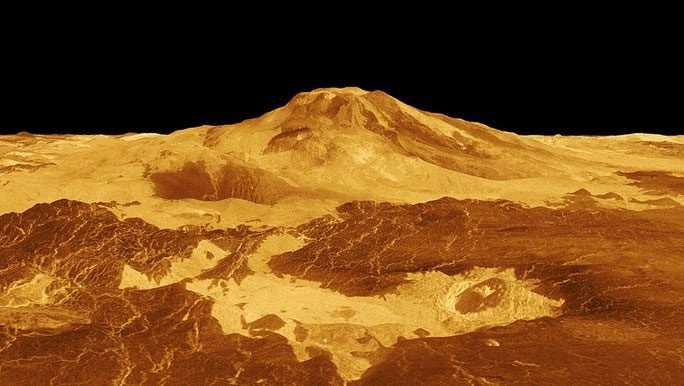American scientists have revisited data from NASA’s Magellan spacecraft, captured over 30 years ago, revealing astonishing evidence that another planet in the Solar System is still geologically active.
The Magellan spacecraft, also known as the Venus Radar Mapper, is a Venus exploration spacecraft launched by NASA in 1989 and concluded its mission in 1994. However, its vast dataset continues to unveil fascinating insights as imaging and signal analysis techniques advance.
This time, a team of scientists led by geophysicist Robert Herrick from the University of Alaska Fairbanks and radar expert Scott Hensley from NASA’s Jet Propulsion Laboratory (JPL) analyzed images collected by Magellan from the early 1990s to 1991.

3D perspective of the Maat Mons region on Venus – (Photo: NASA).
In a report on March 15, NASA indicated that they had identified a clear change in the shape of a volcanic vent on the surface of Venus within just eight months, providing vivid evidence that Venus is still geologically active!
The long-overdue discovery was partly due to the elliptical orbit of this spacecraft, which caused imaging data of each region to contain many errors that required manual analysis rather than automated processing.
This small volcano is located near two of Venus’s supervolcanoes, Ozza and Maat Mons. It may be part of Maat Mons, with data from October 2, 1991, indicating that it appeared to have just experienced an eruption, altering its previously circular shape of 2.2 km2 into a deformed and expanded area of 4 km2.
The surrounding terrain also changed, as if freshly erupted lava had ravaged the area just moments before.
On Earth, geological activity often leads to disasters; however, it is also extremely essential for life as it provides elements that help stabilize temperature, environment, and the chemical composition of the atmosphere…
Thus, discovering a planet with geological activity is a dream for astronomers. It is one of the core factors indicating that a planet may still support life.
Turning back to Venus, it has long been proven to have originated as Earth’s twin, with all the conditions necessary for life – and it still lies within the “habitable zone” of the Solar System – yet it has been plagued by many unfortunate factors during its planetary evolution that caused it to slow down, cease geological activity, and become enveloped by a harsh greenhouse effect.
One reason people once believed that Venus was dead is that its lithosphere is a seamless shell, rather than consisting of many tectonic plates like Earth. Earth’s volcanoes typically erupt at the edges of tectonic plates. However, the new findings suggest that volcanoes on this other planet may have operated differently.
This location will be a mysterious site for future NASA missions to explore. Numerous studies in recent years have discovered potential biosignatures in the planet’s spectrum, which the U.S. space agency has shown a clear interest in.
The new research has just been published in the journal Science.





















































